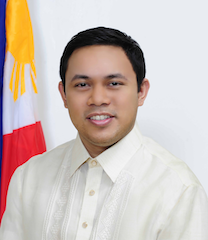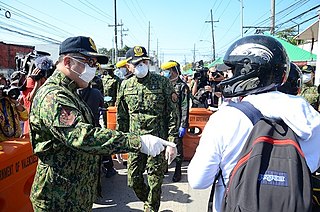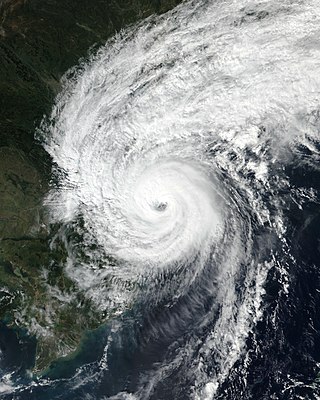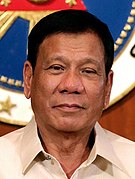
Manila Water Company, Inc. has the exclusive right to provide water and used water (wastewater) services to over six million people in the East Zone of Metro Manila. It is a subsidiary of the country's oldest conglomerate, Ayala Corporation.

The La Mesa Dam and Reservoir is an earth dam in Quezon City, Philippines. Its reservoir can hold up to 50.5 million cubic meters, occupying an area of 27 square kilometers (10 sq mi). It is part of the Angat-Ipo-La Mesa water system, which supplies most of the water supply of Metro Manila.
The Philippines' water supply system dates back to 1946, after the country declared independence. Government agencies, local institutions, non-government organizations, and other corporations are primarily in charge of the operation and administration of water supply and sanitation in the country.
Water privatization in Metro Manila began when the then President of the Philippines, Fidel Ramos, instructed the government in 1994 to solve what he called the water crisis in Manila by engaging with the private sector. In 1997, two concession contracts for the Eastern and Western halves of Metro Manila were awarded after an open competition. The concessions represent the largest population served by private operators in the developing world. Both winning companies, Maynilad Water Services in West Manila and especially Manila Water in East Manila, submitted bids with extremely low water tariffs. The tariffs proved to be too low to finance the investments needed to improve performance, especially after the East Asian financial crisis and the devaluation of the Philippine Peso.

The Metropolitan Waterworks and Sewerage System, formerly known as the National Waterworks and Sewerage System Authority (NAWASA), is the government agency that is in charge of water privatization in Metro Manila and nearby provinces of Cavite and Rizal in the Philippines. It split the water concession into an east and a west concession with Manila Water being awarded one contract and Maynilad Water Services being awarded the other.

Maynilad Water Services, Inc., better known as Maynilad, is the water and wastewater services provider of cities and municipalities that form the West Zone of the Greater Manila Area in the Philippines. It is an agent and contractor of the Metropolitan Waterworks and Sewerage System (MWSS). Maynilad is one of two private water providers in Metro Manila, the other being Manila Water.

Rodrigo Duterte's six-year tenure as the 16th President of the Philippines began on June 30, 2016, succeeding Benigno Aquino III. He was the first president from Mindanao, the first president to have worked in all three branches of government, and the oldest to be elected. He won the election amid growing frustration with post-EDSA governance that favored elites over ordinary Filipinos. His tenure ended on June 30, 2022.

Mark Aguilar Villar is a Filipino politician and businessman serving as a Senator since 2022. He served in President Rodrigo Duterte's cabinet as the Secretary of Public Works and Highways from 2016 to 2021, and was the COVID-19 pandemic isolation czar from 2020 to 2021. A member of the Nacionalista Party, he was the Representative of Las Piñas from 2010 to 2016. Villar has also previously held executive positions in his family's businesses.
DuterteNomics is a catch-all term referring to the socioeconomic policies of Rodrigo Duterte, the 16th president of the Philippines. A significant part of these policies include the development of infrastructure and industries in the Philippines.

Protests against Former President Rodrigo Duterte escalated on November 18, 2016, following Duterte's support of the burial of the late president Ferdinand Marcos. These series of protests are mostly conducted by progressive groups and other opposing figures mainly due to the ongoing war on drugs, the declaration of martial law in Mindanao, and employment issues such as contractual terms being applied by companies and inflation which occurred due to the passage of the Tax Reform for Acceleration and Inclusion Law. Other causes of the protests include the government's response to the COVID-19 pandemic in the country, the passage of the Anti-Terrorism Act of 2020, and the shutdown and franchise denial of ABS-CBN.

The following is a timeline of protests against Rodrigo Duterte, the 16th President of the Philippines, and his policies. Issues were addressed in the protests including the war on drugs, employment issues, anti-terror law, and the government's response to the COVID-19 pandemic.
2019 in the Philippines details events of note that have occurred in the Philippines in 2019.
2020 in the Philippines details events of note that have occurred in the Philippines in 2020. The year is largely defined by the COVID-19 pandemic that caused the national economy to go into recession would continued until the state of public health emergency was lifted in the country on July 22, 2023.

The COVID-19 pandemic in Metro Manila was a part of the worldwide pandemic of coronavirus disease 2019 caused by severe acute respiratory syndrome coronavirus 2. The virus reached Metro Manila on January 30, 2020, when the first case of COVID-19 in the Philippines was confirmed in Manila. Metro Manila is the worst affected region in the Philippines, where most cases in the country are recorded. A state of calamity and community quarantine was declared in the region on March 15.

The enhanced community quarantine in Luzon was a series of stay-at-home orders and cordon sanitaire measures implemented by the Inter-Agency Task Force for the Management of Emerging Infectious Diseases (IATF-EID) on the island of Luzon and its associated islands. It is part of the COVID-19 community quarantines in the Philippines, a larger scale of COVID-19 containment measures with varying degrees of strictness. The "enhanced community quarantine" (ECQ) is the strictest of these measures and is effectively a total lockdown.

The renewal of the congressional franchise of the Philippine media network ABS-CBN to continue broadcasting was a dispute between the administration of President Rodrigo Duterte and the media conglomerate arising on the terms and conditions of the franchise renewal agreement. Amid the controversy, the Congress of the Philippines, country's legislature, was unable to renew the franchise before its expiration date. The congressional franchise expired on May 4, 2020, as the Philippines was dealing with the effects of the COVID-19 pandemic and the enhanced community quarantine in Luzon. The next day, exercising constitutional powers, the National Telecommunications Commission (NTC) then issued a cease-and-desist order demanding ABS-CBN to cease all of its free TV and radio broadcasting immediately. ABS-CBN complied with the government order and shut down all of its radio stations and free television channels later that day. On June 30, 2020, the NTC released two alias cease-and-desist orders against ABS-CBN TV Plus and Sky Direct.

Both the national government and local governments have responded to the COVID-19 pandemic in the Philippines with various declarations of emergency, closure of schools and public meeting places, lockdowns, and other restrictions intended to slow the spread of the virus.

Typhoon Vamco, known in the Philippines as Typhoon Ulysses, was a powerful and very destructive Category 4-equivalent typhoon that struck the Philippines and Vietnam. It also caused the worst flooding in Metro Manila since Typhoon Ketsana in 2009. The twenty-second named storm and tenth typhoon of the 2020 Pacific typhoon season, Vamco originated as a tropical depression northwest of Palau, where it slowly continued its northwest track until it made landfall in Quezon. After entering the South China Sea, Vamco further intensified in the South China Sea until it made its last landfall in Vietnam.

The State of the Nation Addresses of Rodrigo Duterte, the 16th president of the Philippines, were met with several protests.
















